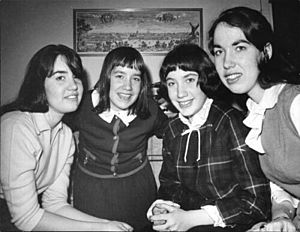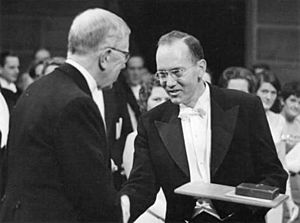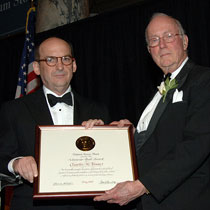Charles H. Townes facts for kids
Quick facts for kids
Charles H. Townes
|
|
|---|---|

Townes in 1983
|
|
| Born |
Charles Hard Townes
July 28, 1915 |
| Died | January 27, 2015 (aged 99) Oakland, California, U.S.
|
| Alma mater |
|
| Known for | |
| Spouse(s) |
Frances Brown
(m. 1941) |
| Awards |
|
| Scientific career | |
| Fields | Physics |
| Institutions |
|
| Thesis | Concentration of the heavy isotope of carbon and measurement of its nuclear spin (1939) |
| Doctoral advisor | William Smythe |
| Doctoral students |
|
Charles Hard Townes (July 28, 1915 – January 27, 2015) was a famous American physicist. He is best known for his work on the maser and the laser. These inventions use special light beams. For his amazing discoveries, he shared the 1964 Nobel Prize in Physics.
Townes was also an important advisor to the United States government. He met with every US president from 1945 to 1999. He even led the science committee for the Apollo program, which helped send humans to the Moon. Later, as a professor at the University of California, Berkeley, he made big discoveries in space science. For example, he helped find the black hole at the center of our own Milky Way galaxy.
Charles Townes was a religious person. He believed that science and religion could work together. He thought they both help us understand the universe and its purpose.
Contents
Early Life and Education
Charles Townes was born in Greenville, South Carolina. His father, Henry Keith Townes, was a lawyer. His brother, Henry Keith Townes Jr., became a well-known expert on wasps.
Charles was a very bright student. He earned two bachelor's degrees from Furman University in 1935. One was in Physics and the other in Modern Languages. He then got his master's degree in physics from Duke University in 1937. In 1939, he earned his PhD from the California Institute of Technology (Caltech).
During World War II, Townes worked at Bell Labs. There, he helped develop radar systems used for bombing.
Career and Big Discoveries
In 1950, Townes became a professor at Columbia University. He led the Columbia Radiation Laboratory for a few years. He was also the head of the Physics Department.
Inventing the Maser and Laser
In 1951, Charles Townes came up with a new idea. He wanted to create strong, focused beams of coherent radiation. He called his invention the maser. This name stands for "Microwave Amplification by Stimulated Emission of Radiation."
In 1953, Townes and his team built the first working maser. It used energized ammonia molecules to create microwaves. Later, when the same idea was used for light, it was called a laser. The word "laser" means "Light Amplification by Stimulated Emission of Radiation."
Leadership and Space Work
From 1959 to 1961, Townes worked for the Institute for Defense Analyses. This group advised the U.S. government on important issues. After that, he became a leader and physics professor at the Massachusetts Institute of Technology (MIT).
In 1967, he moved to the University of California, Berkeley. He stayed there for nearly 50 years. From 1966 to 1970, he chaired the NASA Science Advisory Committee. This committee helped guide the Apollo program to land astronauts on the Moon.
Nobel Prize and Astronomy
For inventing the maser, Townes shared the 1964 Nobel Prize in Physics. He shared it with two Russian scientists, Nikolay Basov and Alexander Prokhorov.
Townes also found ways to use masers and lasers in astronomy. He was part of a team that found complex molecules in space. He also helped figure out the mass of the supermassive black hole at the center of our Milky Way galaxy.
Exploring the Universe
Charles Townes made important contributions to understanding space.
The Milky Way's Center
For a long time, astronomers wondered about the center of our Milky Way galaxy. Thick dust blocks our view of it with regular telescopes. In the 1970s, Townes and his team studied the center using infrared light.
They looked at a spot called Sagittarius A. They saw ionized neon gas swirling around very fast. This meant that there had to be a huge amount of mass in a tiny space. This led them to believe there was a supermassive black hole there. This black hole, called Sagittarius A*, was one of the first ever found. We now know it's about 4.3 million times the mass of our Sun!
Measuring Stars
Townes also helped create a special tool called the Infrared Spatial Interferometer (ISI). This project used three mobile infrared telescopes. They worked together to study the same star. If the telescopes were 10 meters apart, it was like having a giant 30-meter lens.
Using ISI, scientists observed Betelgeuse. This is a large red star in the Orion constellation. They found that Betelgeuse was actually changing size. It grew and shrank by about 1% each year. This technology helps us learn more about stars. It also plays a role in the search for life beyond Earth.
Personal Life and Beliefs
Charles Townes married Frances H. Brown in 1941. They lived in Berkeley, California, and had four daughters.
Townes was a deeply religious man. He believed that science and religion were very similar. He thought they would eventually come together. He wrote that "Science tries to understand what our universe is like and how it works. Religion is aimed at understanding the purpose and meaning of our universe." He felt that if the universe has a purpose, science should be able to see it.
Science and Religion Together
Townes explained his ideas about science and religion in his writings. He felt that both require a kind of faith. Scientists work for years on ideas, not knowing if they will succeed. This is like religious faith.
He also said that many big scientific discoveries come as a sudden "flash" of insight. He felt this was similar to religious revelations. Townes believed we should always be open to new ideas in both science and religion. He thought that new discoveries might change our understanding, but not make us abandon our core beliefs.
Later Life and Legacy
Charles Townes remained active at the University of California, Berkeley, even past his 99th birthday. He visited the physics department regularly.
His health began to decline, and he passed away on January 27, 2015, at age 99. Many people remembered him as one of the most important experimental physicists of his time. His curiosity and positive attitude, based on his strong beliefs, were seen as his greatest strengths.
Selected Publications
Townes wrote many books and articles about his work, including:
- Gordon, J.; Zeiger, H.; Townes, Charles (1955). "The Maser—New Type of Microwave Amplifier, Frequency Standard, and Spectrometer". Physical Review 99 (4): 1264–1274. doi:10.1103/PhysRev.99.1264.
- Shimoda, K.; Wang, T.; Townes, Charles (1956). "Further Aspects of the Theory of the Maser". Physical Review 102 (5): 1308–1321. doi:10.1103/PhysRev.102.1308.
- Schawlow, Arthur; Townes, Charles (1958). "Infrared and Optical Masers". Physical Review 112 (6): 1940–1949. doi:10.1103/PhysRev.112.1940.
- Townes, Charles (1999). How the Laser Happened: Adventures Of a Scientist. Oxford University Press. ISBN 978-0-19-512268-8. https://archive.org/details/howlaserhappened0000town.
- Townes, Charles; Schawlow, Arthur (1955). Microwave Spectroscopy. McGraw-Hill. ISBN 978-0-07-065095-4. https://archive.org/details/microwavespectro0000town.
- Townes, Charles (1995). Making Waves. 432. American Institute of Physics Press. pp. 153. doi:10.1038/432153a. ISBN 978-1-56396-381-0. PMID 15538346. https://archive.org/details/makingwaves00town_9.
Awards and Honors
Charles Townes received many awards for his important scientific work:
- 1956 – Elected to the National Academy of Sciences.
- 1958 – Awarded the Comstock Prize in Physics.
- 1962 – Received the Stuart Ballantine Medal.
- 1963 – Awarded the Young Medal and Prize for optics research.
- 1964 – Won the Nobel Prize in Physics for the maser and laser.
- 1969 – Received the Golden Plate Award from the American Academy of Achievement.
- 1970 – Awarded the Wilhelm Exner Medal.
- 1976 – Elected a Foreign Member of the Royal Society.
- 1979 – Received the Niels Bohr international medal.
- 1982 – Awarded the National Medal of Science by President Ronald Reagan.
- 1983 – Appointed to the Pontifical Academy of Sciences.
- 2000 – Awarded the Lomonosov Gold Medal by the Russian Academy of Sciences.
- 2005 – Won the Templeton Prize for his work on science and spiritual realities.
- 2006 – Received the Vannevar Bush Award for lifetime contributions to science.
- 2010 – Awarded the SPIE Gold Medal.
- 2012 – Received the Golden Goose Award for government-funded research.
Images for kids
See also
 In Spanish: Charles Hard Townes para niños
In Spanish: Charles Hard Townes para niños





